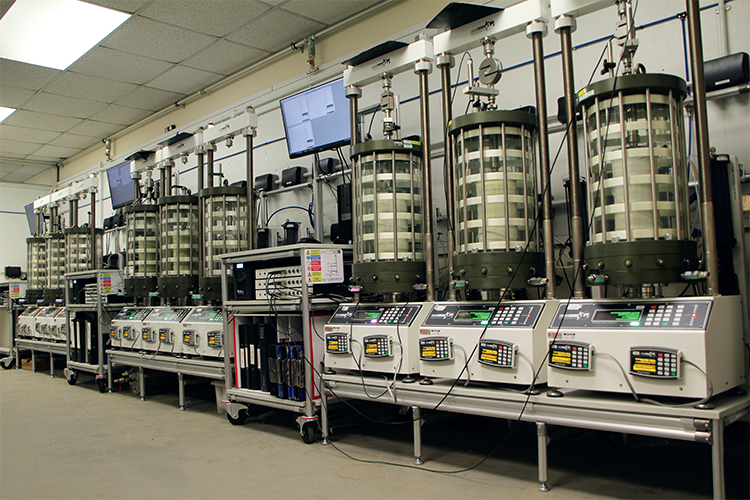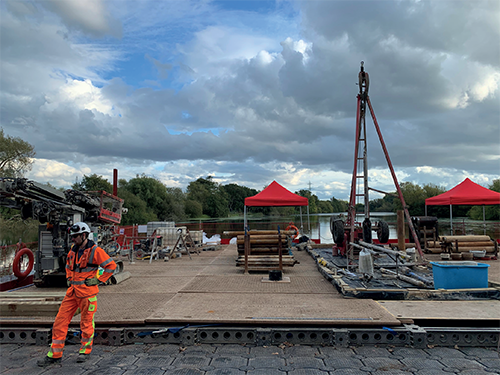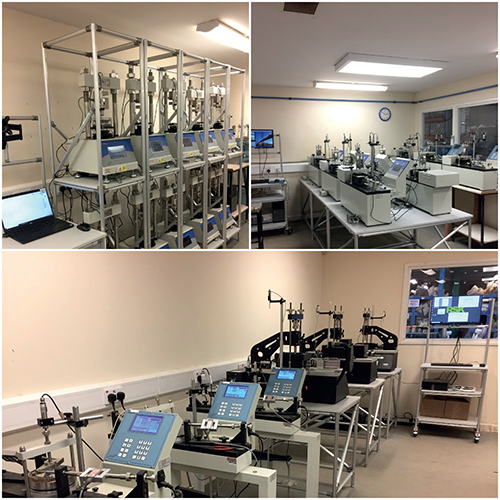
Structural Soils
From the ground up
One of the premier, award-winning, ground investigation companies in the UK, Structural Soils aims to strengthen its reputation for high-quality, non-confrontational service across the next decade
In many ways, Structural Soils is a company that has gone full circle. Founded in the 1960s, as a subsidiary of Masters Engineering, the company cut its teeth carrying out ground investigations work to support its parent firm’s civil engineering projects, both domestically and overseas. After becoming independent in 1982, the Bristol-based firm grew steadily in its own right, upgrading its premises and taking on progressively larger projects. To help facilitate the growing demand for its services, Structural Soils opened a second location in Knottingley, Yorkshire in 1996 before acquisition in 2007 by leading environmental, engineering, and technical services group RSK. The business has remained on a positive trajectory ever since, using existing RSK premises to establish regional offices in Hemel, Glasgow, Coventry, and Wigan in subsequent years.
“At the time of our purchase by RSK, we were turning over just shy of £10 million, with around 130 people on our team,” explains Steve ‘Mac’ Mackereth. “Since joining RSK, however, we have gained the confidence and had the support to take on bigger and bigger projects, which has allowed us to triple our turnover to £30 million.”
Operating from multiple strategically placed locations around the UK enables Structural Soils’ to have an extensive ‘local presence’ and intimate knowledge of ground conditions in broad-reaching areas of the UK. Not only does this minimise staff travel times and improve safety and sustainability, but it also ensures that the organisation can reach customers in all corners of the nation without having to go ‘too far’.
“We endeavour to provide a comprehensive service, undertaking all elements of ground investigation for a broad variety of clients,” Mac says. “With the help of our experienced engineers, project managers and operatives, we can carry out all site management, drilling and in situ testing needs ourselves. Samples collected onsite can then be tested in any of our four UKAS-accredited Soil, Rock and Materials testing laboratories.”
Over the years, Structural Soils has gradually increased the number of services it offers – from desk studies to consultancy, service avoidance to intrusive investigations – gradually reducing reliance on third-party suppliers to support its work. Crucially, having built a favourable reputation with its clients over the last 50+ years, the organisation retains, according to Associate Director Eric Downey, two or three key market differentiators.
“One thing that is always true of Structural Soils is that we put quality first,” Eric declares. “We might not be the cheapest, but we really value the delivery of a high-quality product and rarely does our tendered cost of a project increase.
“In addition to this, I think the friendliness and non-confrontational culture of the business makes us stand out. We get a lot of feedback from clients saying that we are very easy to work with, and that reputation certainly helps to separate us from the pack.”
In recent times, Structural Soils has supported work on a wide array of significant strategic developments, including HS2, the Lower Thames Crossing project and numerous Nuclear New Build (NNB) Projects. One particularly successful example of the company’s work occurred around two years ago, when it carried out a major ground investigation for a new nuclear power station at Bradwell in Essex. Mac reveals more: “In the mid-2010s, a new nuclear power station was proposed on arable land in rural Essex,” he begins. “There were some considerable gaps in the understanding of the ground conditions and geological structure at this time. There had been an investigation on the land in the 1980s as part of the NIREX project, but a detailed understanding of the geology of the site was still a bit of a mystery as the historical drilling attempts had been unable to recover sufficient high-quality undisturbed core samples of the London Clay and underlying geologies.
“Our involvement in the project commenced by undertaking an initial desk study, followed by an extensive campaign of surface geophysical surveys over a three-month period, in quite challenging climatic conditions. Techniques ranging from deep seismic reflection to ground resistivity were used to build up and develop a geological and structural model of the site and adjoining areas. We worked hand-in-hand with our sister company RSK Geophysics to deliver this work and the initial phases were undertaken on a trial basis, allowing methodology to be adapted as the work went on to provide the best and most refined model possible.”
Following this preliminary work and, at least in part, using the findings of the Geophysical survey to define the scope and location on investigations,
Structural Soils worked closely with the client in undertaking a large intrusive investigation at the site over a five-month fieldwork program.  Despite not specifically understanding at the outset which drilling techniques would retrieve the best quality and highest possible recovery of the mixed and challenging geologies, experimental trials and collaborative discussions with the client and the investigation supervisor ultimately led to outstanding results.
Despite not specifically understanding at the outset which drilling techniques would retrieve the best quality and highest possible recovery of the mixed and challenging geologies, experimental trials and collaborative discussions with the client and the investigation supervisor ultimately led to outstanding results.
“Our good relationship with the client gave us room for experimentation,” Mac states. “After drilling an initial two or three bore holes using a variety of techniques, we established the optimum method and, overall, achieved >95 percent recovery rate from the almost 2.5 km of wireline cored boreholes undertaken as part of the investigation.
“There was also a broad range of in situ testing undertaken as part of this investigation including high-pressure and self-boring pressure-meter, down-hole and cross-hole seismic and seismic CPT testing, and some methods that were quite experimental.
“The combined results of our work produced a really solid understanding of the geology and the geotechnical, including elastic properties of the soils and rocks beneath the site – knowledge which is vital when you are designing a nuclear power station because you need to know how a potential geological setting would respond in a seismic event. The consultant we were working with was very pleased with the end product.”
In support of its work, Structural Soils continues to invest in market-leading technology and infrastructure. For instance, the company recently purchased three new sonic drilling rigs.
“Sonic drilling was one of those things we thought about long and hard,” Mac points out. “It’s a drilling method that has been around a while, but it’s only just regularly started to be specified on larger projects and it was always very expensive to subcontract, so we decided to dip our toe in the water ourselves. More than just invest in sonic drilling though, we worked with the rig supplier to develop units that have a sonic head, as well as a dedicated rotary head. It means that, when we get down to a level where we want to start using rotary, we don’t have to compromise on efficiency. The separate, dedicated sonic and rotary heads provide these drills with the best of both worlds.”
Alongside its sonic rigs, Structural Soils has invested heavily in the laboratory side of its operation. A recent £1 million investment has enabled the company to bring more of its rock and soil testing in-house, while a separate £100,000 injection of funds into the firm’s ‘Red Lab’ now allows Structural Soils to geotechnically test contaminated samples in a setting that is safe for technicians and the environment.
“We have, for many years, undertaken a wide range of accredited soil testing in our laboratories, particularly for our work on large strategic investigations, including in the NNB sector. To supplement this, and because a number of nuclear facilities are on hard rock geology sites, we have really extended our accredited rock testing capabilities in the last few years,” Mac remarks.
“Furthermore, over the last 18 months, in order to satisfy the requirements of the HS2, LTC and various Highway projects, as well as NNB investigations on softer geologies, we have invested heavily in the soils laboratory to enable us to undertake advanced triaxial testing, which measures the elastic properties of the soil in addition to the strength. We have relied on third-party suppliers for this kind of testing in the past, but we have, at times, been let down. Our investigations are only as good as their weakest component, so by internalising this testing, it allows us to better control quality, cost and program duration.
“Finally,” Mac adds, “our Red Lab, which is only a couple of years’ old now, can be used to test contaminated materials in a safe environment. Building materials that are going to be reused, for example, often contain contaminants like hydrocarbons or asbestos, and you wouldn’t want technicians coming into direct contact with these, so we have created a special, negative-pressure lab, where the team works in full PPE with powered respirators. It means that we can test demolished building material and assess its potential for re-use as aggregates and the like, while keeping our people safe.”
As some of the company’s recent investments suggest, one of Structural Soils’ key short-term goals will be to bring more capabilities in-house, such as wireline geologging. The objective, Mac argues, is to increase the firm’s ability to control and undertake all aspects of an investigation, whatever the client might request.
“We want to improve the quality of our service offering and to internalise allied services that we sensibly can,” Mac affirms. “We have a lot of repeat clients already, but we want to continue building on our reputation for quality. Bringing more services in-house and under our control helps achieve this aspiration.
“We have just had our most successful financial year at Structural Soils, but we are always looking for ways to improve. In 2022, that next step will involve making our offering more sustainable and reducing the negative carbon impact of our operations. Following Covid-19, some of our staff can now work from home, which reduces pollution from commuting and decreases our energy usage at the office. We are also looking at the types of fuel we use in the plant and the alternative possibilities out there. All these elements of our operation are under the spotlight, and we hope that, by addressing them now, we can be a better, stronger, more modern business for years to come.”
Structural Soils
www.soils.co.uk
Services: Ground investigation company